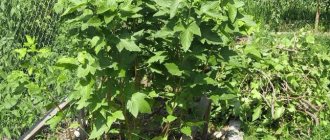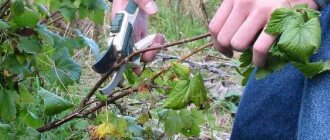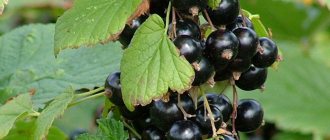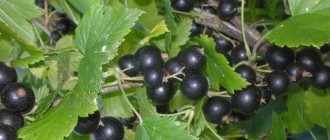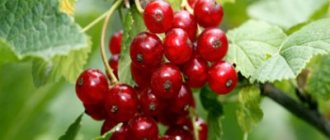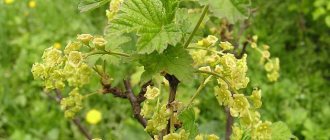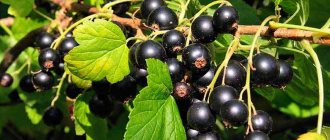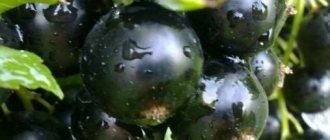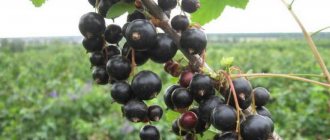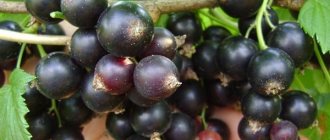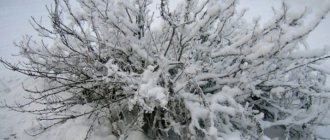Black currant variety “Izyumnaya” is an early ripening plant, frost-resistant, capable of providing the gardener with a harvest of delicious berries. Gardeners are required to pay attention and follow all recommendations.
The currant fruits of the “Izyumnaya” variety are able to compete with analogues in terms of the content of nutrients and microelements. It is important for gardeners to strictly follow the recommendations for planting and caring for shrubs in order to obtain a healthy plant and a bountiful harvest from early-ripening blackcurrants.
Description of the black currant variety Izyumnaya
Izyumnaya currants were bred by specialists from the All-Russian Scientific Research Institute Lupin (Bryansk region) by crossing the hybrid form 37-5 with the early ripening variety Seyanets golubki. The main goal of breeding was to obtain a crop with good immunity to powdery mildew. The author is A.I. Astakhov. The variety he bred has been listed in the State Register since 2007 and is approved for use in the Central region. In practice, it is grown throughout the country.
Currant Raisin forms upright and fairly compact bushes. Their height is average, does not exceed 1.5 m. The crown is not spreading. Young shoots are geniculate. They are green in color and have a matte surface. There is pubescence. The shoots are thick and flexible.
The roots of the Izyumnaya currant have a fibrous structure. They go to a depth of 0.35 m.
The flowering of Izyumnaya currant begins in the first ten days of May. Quite long brushes form on the bushes. Each has 7-11 large, pale yellow flowers with five petals.
Currant Raisin has three-lobed leaves with medium-sized notches and small but deep notches at the bases. Their surface is leathery and wrinkled, their shape is convex, and their color is dark green. The edges of the leaf blades have blunt teeth. The middle blades are long, their tips are medium-pointed.
Currant Raisin produces large, round fruits. Their color is matte black, their weight can reach 3.3 g. Such indicators are ensured by proper comprehensive care.
The berries of this variety have a sweet taste. Almost 10% are sugars, while acids are contained 5-6 times less. There are about 200 mg of vitamin C per 100 g of pulp. Raisin currants are classified as dessert varieties. Its tasting score is 4.3 points.
The fruits of Izyumnaya currants ripen already at the beginning of July, their ripening is smooth
History of creation
Black currant Raisin was created by the All-Russian Research Institute of Lupine under the leadership of Alexander Ivanovich Astakhov. To do this, he crossed the currant variety Seedling Dove and the form 37-5. The result of the work has been in the State Register since 2007. Raisin currants are recommended for cultivation in the Central region, but gardeners are happy to plant them in many other places.
Black currant Izyumnaya has features that are rarely seen in other varieties.
Characteristics
The optimal temperature for growth and fruiting of Izyumnaya currant is 20-25 °C. This variety tolerates heat well.
Drought resistance, frost resistance
Currant Raisin exhibits relative resistance to drought. This variety is not afraid of sudden temperature changes. In terms of frost resistance, it belongs to zone 4a, since it can withstand cold temperatures down to -34.4 °C.
Productivity
Izyumnaya currants begin to bear fruit in the first half of July. On average, you can collect 1.7 kg of berries from a bush, the maximum yield reaches 3.5-4 kg. The first five years after planting the indicators are low. Fruiting begins in the second year and lasts until about 15 years.
Raisin currants are not prone to shedding due to the special structure of the cuttings. The berries can remain on the bush almost until autumn. Gradually, under the sun, they wither, turning into a kind of raisins. This feature gave the variety its name.
As the branches age, the berries become noticeably smaller. Productivity may decrease due to ovary falling off during heat or drought.
Important! Acidic soil is not suitable for Raisin currants. This is fraught with inhibition of growth, crushing of berries, and reduced yield.
Application area
The fruits of the Raisin currant are universal. They are good fresh, suitable for freezing and canning - making preserves, jams, compotes, juice. The leaves of this variety are also used, adding them for taste and aroma to tea, pickling, and using them in folk medicine.
If you pick Raisin currants in dry weather, the berries tolerate transportation well. For it you need to choose small containers that must be ventilated. The fruits store well if collected before they wither.
Harvesting and transportation, keeping quality of berries
The berries of the Raisin hybrid form have a good shelf life - up to two weeks in the refrigerator, but provided that the crop was harvested in dry weather and the berries were not washed before storage.
Picking berries of the Raisin variety is quite convenient: they tear off well without releasing juice. For collection, you can take flat containers: boxes or plastic containers. It is recommended to collect the fruits immediately into the container in which they will be stored. Currants tolerate transportation well, even over long distances; the main thing during transportation is to periodically ventilate the berries.
As you can see, if desired, every gardener can grow a selective variety of currant on his plot - Izyumny, which will delight you with delicious berries and a bountiful harvest. And fruits not picked in time will make excellent raisins.
Advantages and disadvantages
Raisin currants contain a lot of sugar compared to other varieties. This gives it a sweet dessert taste.
The clusters of Izyumnaya currants are large, making the berries easy to pick
pros
- resistance to frost, drought, temperature changes;
- large fruits;
- the berries do not fall off, losses are minimal;
- earlier maturation;
- ease of care;
- good immunity to powdery mildew;
- resistance to kidney mite.
Minuses
- poor rooting by lignified cuttings;
- susceptibility to septoria.
Disease resistance
Raisin is immune to fungal infections of black currant (American powdery mildew) and is not affected by the bud mite. According to reviews, spider mites do not bother her either. One or two treatments per season with a systemic insecticidal preparation will provide protection against other insect pests (aphids, glass beetles, moths). At the initial stages of the lesion, you can get by with folk, environmentally friendly remedies.
Aphids weaken the plant and make it susceptible to diseases. It can be eliminated by treating the affected bushes with a soap solution, a decoction of ash (300 g per bucket), a solution of urea (3 tablespoons per bucket), boric acid, coniferous or celandine infusions.
The moth attacks currant fruits. Its larvae overwintering in the ground are prevented by mulching or covering the soil with insect-proof material. Metafos, Actellik, Karbofos destroy moth caterpillars on branches. The Golubka variety is also susceptible to moth damage.
Glassworm caterpillars eat away currant shoots from the inside. Helps against glasswort: sanitary pruning, spraying with Aktara (mustard, celandine or tansy infusion) before buds open, maintaining the overall health of the plant.
A description of the currant variety Dachnitsa can be found here.
Landing
You can plant Raisin currants in the spring before the buds open or in October. The second option is preferable, since the bushes have time to take root before frost, and next year full growth and development begins.
Currant Raisin prefers sunny areas. They should be well ventilated, but not too ventilated. The soil needs to be loose and moisture-permeable, preferably loam and sandy loam enriched with organic matter. The reaction should be neutral or close to it.
Comment! For Izyumnaya currants, you need to choose an area where there is no standing water after the snow melts. The close occurrence of groundwater is detrimental to bushes.
Seedlings must be selected carefully. A healthy and well-developed root system without mechanical damage or signs of rot is important. The shoots should be flexible and succulent, the foliage without spots.
Before planting, the selected area must be dug up and added per 1 m²:
- rotted compost or humus 7-10 kg;
- superphosphate 0.1 kg;
- wood ash 1 liter or potassium salt 80 g.
It is recommended to carry out preparation 4-6 months before planting. The further algorithm is as follows:
- Make a hole with a side of 0.4-0.5 m.
- Fill the hole 2/3 with soil mixture. If no preparation has been made, then add a bucket of compost or humus, 0.2 kg of superphosphate, 0.4 kg of wood ash.
- Pour in 0.5 buckets of water.
- Place the seedling at an angle of 45°, deepen the root collar by 7-10 cm.
- Straighten the roots and cover with soil mixture.
- Compact the soil and water (0.5 buckets of water).
- Mulch the planting with dry soil or any organic matter.
When planting in spring, the branches need to be trimmed, leaving 3-4 buds. This stimulates the growth of new shoots. When planting in autumn, hilling is necessary. In early spring, excess soil will need to be removed and the bush trimmed.
Comment! Raisin currant bushes are compact, so they can be planted at intervals of 1 m. The lifespan of plants is reduced when planted closely.
It is better not to plant Raisin currants between trees, this can reduce the yield
Advantages and disadvantages of the variety
One of the main advantages of the variety is the long-term storage of berries on the bush. They do not crumble, but dry, turning into raisins. Berries contain 10 times more sugar than acid. The brushes are large and easy to collect. The advantages of the variety also include its winter hardiness, drought resistance, resistance to diseases and pests: bud mites, powdery mildew and fungi.
Breeders consider poor rooting by woody cuttings to be a disadvantage of this variety. Selection work in this direction continues.
To get a good harvest of this currant variety, you need to:
- Have on your land plot currant bushes that satisfy your needs: high-yielding with large berries;
- Plant young plants in fertilized soil in the autumn;
- Carry out fertilizing and mulching;
- Regular watering and sprinkling;
- Inspection of bushes and control of aphids;
- Mandatory thinning of bushes.
As a result, Izyuminka currants will please gardeners, summer residents and home gardeners with a good harvest.
Aftercare
Currant Raisin requires comprehensive care:
- Evening watering. It is better to use a sprayer with a fine nozzle, irrigating the plantings for 1-2 hours. In dry weather, moisten the bushes at least twice a week. In spring and autumn, carry out one abundant watering - 40-50 liters per plant.
- Regular weeding.
- Mulching to retain moisture.
- Feeding. In spring, 40 g of urea per bush. After flowering and during fruiting, per plant a bucket of water with 20 g of superphosphate and 10 g of nitrogen and potassium fertilizers. After harvesting, 20 g of potassium sulfate or a glass of ash and 50 g of superphosphate.
- Trimming. Up to five years, form a crown of 15-20 strong shoots. From the 7th year of life, for rejuvenation, remove old branches, leaving 4-5 one-year-old specimens. Sanitary pruning is carried out in summer or autumn.
Comment! From the end of summer, nitrogen cannot be used for currants. It stimulates the growth of new shoots that do not have time to ripen before the cold weather.
Shelter for Izyumnaya currants is required only in regions with harsh winters, when weakened after an illness, and also in the first two years of life. Short shoots of young bushes can be covered with cloth and covered with earth. The branches of old plants should be pinned with pegs, and non-woven material should be spread on top.
Agricultural technology
Agrotechnical processes come down to proper planting, care (watering, fertilizing), pruning and shaping the bush, combating attacks of diseases and pests, as well as preparing for winter.
Important! The productivity of the Raisin variety can be attributed to both advantages and disadvantages. The fact is that yield indicators directly depend on weather conditions: if rainy weather with high air humidity persists for a long time, then the yield can rapidly decrease.
Choosing a place and landing
The first thing that anyone who wants to grow the Raisin variety of currants on their plot must decide on is the correct choice of planting site, taking into account criteria such as humidity and lighting.
When choosing a seat, be guided by the following requirements of a given crop:
- good lighting: currants will not grow well in shaded conditions. For effective productivity and life, it needs sunlight. You can plant bushes along fences or paths;
- looseness, lightness and fertility of the soil;
- moderate humidity: choose a site on a slight rise or slope. The selection hybrid does not welcome close groundwater, as well as swampy or overly moist conditions: its root system will rot, which will entail the death of the entire bush;
- soil acidity: the crop prefers soils with a neutral pH level (6.0–6.5);
- protection from drafts and winds. Gardeners have come to the conclusion that the variety does not welcome windy areas, especially if the winds blow from the north or northeast.
As for planting time, it can be done both in spring and autumn. However, it is preferable to carry out planting of the Raisin variety in the autumn, since the young plant will spend time and energy on rooting not during the productive period, but during the cold season. The optimal time for autumn planting is early to mid-October: it must be calculated so that the crop has time to take root before the onset of frost. In spring, the Raisin varietal form is planted in early April, before the buds open.
Important! If planting procedures are carried out in the autumn, the seedlings are hilled up and not pruned. Spring planting should be accompanied by pruning of branches: it is necessary to leave 3
–
4 buds without hilling.
The landing procedure consists of the following steps:
- Digging planting holes with parameters 50x50x50.
- Mixing the soil removed from the pits with fertilizers: compost (1 bucket), superphosphate (200 g), ash (400 g) or potassium sulfate (70 g), limestone (200 g).
- Fill the holes 2/3 full with the nutrient mixture.
- Adding a bucket of water to the planting hole.
- Place the seedling in the hole at an inclined angle of 45º. In this case, you need to ensure that the root collar is 7–10 cm below the level of the top soil layer.
- Free placement of roots in the hole.
- Fill the hole with the remaining mixture.
- Compact the soil, mulch the seedling, water with half a bucket of water.
The optimal distance between bushes is 1.5–2 m, but due to the compactness of the Raisin bushes, their planting can be compacted by maintaining a distance of 1 m. Gardeners who cultivate the plant for industrial purposes resort to this method: the yield from planting will increase, but The lifespan of the bush will decrease.
Care
During the first two years of life, the Raisin variety will not need fertilizing, since sufficient fertilizer was added to the hole when planting. With the onset of spring, immediately after the snow melts, complex fertilizers are applied to the plant: a mixture of 10 g of nitrogen, 10 g of potassium and 20 g of superphosphate fertilizers for each bush. The same mixture is applied after the crop blooms and after the berries have filled. After harvesting, feed the depleted bush with 50 g of superphosphate and 20 g of potassium sulfate, which must be diluted in 10 liters of water. In autumn, the shrub needs feeding in the form of manure or compost (6 kg).
Important! According to reviews from experienced gardeners, after applying spring and autumn fertilizing, the shrubs must be watered using 40–50 liters of warm water, since nutrients enter the root system only with water. It is first necessary to loosen the soil around the plant.
Despite such a characteristic as drought resistance, the variety’s shrubs need watering, since a long period without water can have a bad effect on the quality of the berries. It is recommended to water the plant 2 times a week. For one bush you need to spend 1-2 buckets of water. The crop especially needs watering when it blooms and during the formation of ovaries. The optimal method of watering the Raisin variety is sprinkling for 1–2 hours. To carry out the irrigation procedure, it is important to use a sprayer with a fine nozzle.
Disease and pest control
Pests can covet the vital activity of currant bushes, as well as their harvest. The bush may also suffer from diseases. Both must be dealt with immediately, so as not only not to lose the harvest, but also not to lose the currant plantings at all.
Important! It is prohibited to spray currant bushes with insecticides later than 14 days before harvest.
More information about the most common diseases and pests that can harm the Raisin variety:
- Septoria is a fungal disease that can be called the “Achilles heel” of the Raisin variety, since the breeding hybrid is very sensitive to the attacks of this fungus. The fact that the bush is sick is indicated by brown spots formed on the foliage. In the center of each spot there are white dots, which is why septoria is also known as white spot. A rapid increase in the diameter of the spots leads to the death of foliage and its fall. If measures are not taken, the disease will spread to the kidneys and lead to their death, and this will lead to the cessation of the growth of existing shoots and the formation of new ones. For preventive purposes, spring spraying of shrubs with any insecticide that is made on the basis of copper is carried out; To combat white spotting, it is appropriate to spray the bushes with a 3% solution of copper sulfate or a 1% solution of Bordeaux mixture.
- anthracnose (brown spot) - the disease is caused by pathogenic fungi, which is fraught with premature leaf fall of the crop: small dark spots form on the foliage, the diameter of which rapidly increases. After the plant sheds diseased leaves, the disease spreads to the berries, which negatively affects them: both the yield and the quality of the fruit decrease. It is advisable to fight the fungus using a 1% solution of Bordeaux mixture. This treatment is carried out not only when the plant is already sick, but also for preventive purposes;
Anthracnose is afraid of copper, so it would be appropriate to treat the bushes with any 1% solution of copper-based insecticides. - reversion or terry disease is a disease caused by specific viruses that settle in currant juice and spread like lightning throughout the entire bush. Soon the plant becomes depressed, its flowers are thread-like, the inflorescences are covered with a terry coating, and the shoots with foliage are susceptible to deformation. There are no effective methods to combat the disease, since its sources are inside the plant. The bush will have to be removed from the site and the soil underneath it should be disinfected with a 1% solution of colloidal sulfur; It is advisable to carry out preventive treatment of the bushes in spring and autumn with the same colloidal sulfur (1% solution)
- aphid is a small pest, the presence of which on a bush is accompanied by deformation of the foliage and the appearance of red-brown swellings on the leaves. Aphids are fraught with premature leaf fall and slower growth of stems. The bushes are also sprayed with the indicated preparations for preventive purposes;
In order to eliminate the pest, spray with “Biotlin”, “Fitoverm”, “Agravertin”. - currant mite - one of the most dangerous pests, since it is fraught not only with loss of crop yield, but also with the cessation of growth and development of its bushes. It is impossible to see the currant mite with the naked eye due to its small size; for this you will need a magnifying glass, so it is not possible to eliminate the pest in a timely manner. The currant mite is dangerous due to damage to the kidneys, which it chooses as a place for wintering. The female pests lay eggs in the kidney cells, from which new mites hatch throughout the winter and suck out the kidney juices. A signal about the appearance of a tick is the half-opened buds of the crop in the spring, which in appearance resemble small, slightly swollen balls. Buds affected by the pest must be removed along with the shoots on which they grew;
It is recommended to treat the bushes with a suspension of colloidal sulfur - 75 g/10 l of water during the period of throwing out flowers, and after flowering it is important to treat them with a 1% sulfur-lime solution - currant borer - a harmless, at first glance, small yellow-green bug that can cause irreparable harm to currants. The fact is that borer larvae settle in currant shoots, drilling passages there. Such actions of the pest are fraught with drying out and death of the stems. But this is not the limit of harm: adult borer beetles feed on currant foliage, and they absorb it quite quickly. Treatment with karbofos solution (0.3%), which is also advisable for prevention, will help eliminate the uninvited guest;
It is recommended to treat the bushes with a suspension of colloidal sulfur - 75 g/10 l of water during the period of throwing out flowers, and after flowering, treatment with a 1% sulfur-lime solution is relevant. - blackcurrant berry sawfly - a pest that attacks the fruits of the crop as soon as they set: small larvae settle inside the berries. The plant signals the appearance of such an uninvited guest by the ribbed shape of the fruits and a slight increase in their size. The larva lives inside the berry and feeds on its seeds. Then it gnaws a small round hole, crawls out, pupates and remains to overwinter in the soil. Such a pest is fraught with crop loss. To eliminate it, you need to collect and destroy the wormy fruits before the larva leaves them.
It is recommended to spray the bushes with a 0.3% chlorophos solution. For prevention purposes, the soil is dug up in the fall.
Pruning and shaping the bush
In the first 6 years of life, the Raisin bush needs formative pruning, and in subsequent years - rejuvenating. So, immediately after planting (in spring), the shoots are shortened to the level of 3-4 buds, which stimulates the growth of new stems from the root collar. With the onset of spring, the second year of the plant’s life, the gardener needs to conduct a thorough inspection of the bush, select 2-3 of the most powerful and healthy shoots, and completely cut off the rest. In summer, the remaining stems will need to be shortened by 10 cm each, which will provoke their good branching.
Fig.1. Currant pruning: a - one-year-old seedling; b - two-year-old bush; c, d - shortening of shoots. Fig.2. Currant bush before anti-aging pruning (a), after it (b) and pruning of a neglected bush (c).
In the autumn and spring of each year, it is necessary to carry out sanitary pruning of diseased, dried, broken and weakened stems. After the shrub turns 6 years old, it needs to be rejuvenated: cut off old shoots so that it spends energy on the growth of young ones.
Wintering
Young currant bushes (up to 2–3 years), as well as plants that have suffered the disease, need shelter for the winter. It is also necessary to cover the crop in regions where winters are frosty and have little snow. The shoots must be pinned to the ground using special pegs, and then covered with roofing felt or agrofibre.
Did you know? Several centuries ago, currants were considered a monastic berry, since they were grown in every monastery, since the monks consumed the fruits of the crop as food and used it for medicinal purposes.
Pests and diseases
Currant Raisin is especially susceptible to septoria, also called white spot. The disease most often occurs in the first half of June and manifests itself as small brown spots on the leaves, which gradually turn white in the center. The greenery dries out en masse and falls off prematurely. Possible fruit cracking.
Parts of the plant affected by septoria must be removed and burned. Treat plantings with a copper-containing preparation. For prevention, you need to remove weeds and fallen leaves, dig up the soil to 8-10 cm in the fall, and do sanitary pruning annually.
The appearance of septoria is favored by high humidity and little snowy winters.
Landing algorithm
To get a high-quality and large harvest of healthy berries, you need to follow the rules of planting and caring for the fruit crop.
Optimal timing
In southern and temperate climates, it is recommended to plant currant seedlings in open ground in the fall, 4-6 weeks before the first frost. In this case, the bushes will take root and begin to bear fruit in the summer. In regions with cold winters, the planting of currant bushes is postponed to the spring.
Site selection and preparation
For planting berry crops, choose sunny, level, dry plots of land that are protected from drafts. Also, groundwater must be at least 1.5-2 m from the ground surface. Work on soil preparation begins 3-4 weeks before planting the seedlings.
- The selected area is carefully dug up, cleared of weeds and loosened.
- The soil is mixed with humus, mineral and organic fertilizers.
- Lime or wood ash is added to soil with a high acid content.
- Clayey, heavy soil is mixed with sand and humus.
- If sandy soils predominate on the site, then river sand and peat are added to it.
Important! Hybrid currant bushes are not recommended to be planted in lowlands and wetlands. High humidity causes the rhizome to rot and the plant to die.
Preparing the beds and planting hole
When choosing seedlings, first of all, pay attention to the integrity and health of the roots. Rhizomes should not be broken, overdried or damaged. Any growths, formations, putrefactive and fungal manifestations are not acceptable.
- Planting holes are dug in a prepared area with fertile soil.
- The depth and width of the holes is from 45 to 50 cm.
- The distance between plantings is from 80 cm to 1 m, between rows is 1.5 m.
- A drainage layer of broken stone or crushed stone is laid at the bottom of the hole.
- Next, fertile soil is poured in the shape of a small mound.
When preparing planting holes, it is necessary to take into account the size of adult plants. The more ventilation the berry bushes have, the lower the risk of developing fungal and viral infections.
Landing technology
Before planting in open ground, the roots of the seedling are soaked in warm, settled water and treated with antibacterial agents.
- The seedling is placed on the top of the mound at a slight slope.
- The roots are evenly distributed in the hole and carefully covered with fertile soil, trying not to leave any voids between the roots and the soil.
- The soil under the bush is compacted and watered.
After planting, the tree trunk circle is mulched with peat mixed with sawdust or straw.
The best varieties of red currants for the middle zone and their photos
Existing varieties of red currant cannot be attributed to any specific species. In most cases they originate from the red currant (Rribes rubrum). With. common (R. vulgare), p. rocky (R. petraeum), other species were also used in breeding some forms.
The best varieties of red currants with compact or slightly spreading branches are suitable for decorative use. Sprawling bushes will fall apart. It is better to choose varieties that are resistant to the main currant diseases - powdery mildew and anthracnose.
Currant varieties with white fruits:
Belka is a mid-early ripening variety
The bush is slightly spreading, with large, wrinkled, dark green shiny leaves. The brush is medium, loose. The berries are medium-sized, transparent, yellowish in color. Relatively disease-resistant variety.
Advantages: characterized by high winter hardiness.
Cream – medium-early ripening variety
The bush is semi-spreading. The leaves are medium sized, dark green, wrinkled, matte. The brush is long and dense.
Look at the photo - the berries of this variety of red currant are medium-sized, creamy, sweet and sour:
Advantages: the variety is resistant to anthracnose.
White Fairy - self-fertile variety of medium ripening period
The bush is compact and dense. The leaves are medium-sized, dark green, leathery. The brush is long. The berries are medium-sized, white, transparent, tender, tasty.
Advantages: winter hardiness, relative resistance to fungal diseases.
Bayana is a late ripening variety
The bush is dense, slightly spreading. The leaves are large, light green. The brush is long and dense. The berries are medium-sized, white, transparent, one-dimensional, sweet and sour.
Advantages: the variety is winter-hardy, disease-resistant.
Different berry crops have different weights of berries. For red currants, the average weight of the berries is about 1 g, for golden currants - 2-2.5 g, and for honeysuckle - only 0.5 g.
Varieties of currants with pink berries:
Dutch pink - self-fertile variety of medium ripening period
The bush is vigorous, slightly spreading, sparse, with matte, medium-sized leaves. The brush is long. The berries are large, bright pink, sweet. The variety is medium winter hardy.
Advantages: it has a good taste of berries, a relatively disease-resistant variety.
Prygazhunya – medium ripening variety
The bush is medium-sized, slightly spreading, with medium-sized matte leaves. Medium size brush. The berries are medium-sized, light pink, sweet and sour.
Advantages: the variety is winter-hardy, relatively resistant to diseases.
Rossoshanskaya is a self-fertile variety of medium-late ripening
The bush is vigorous, semi-spreading, does not thicken. The cluster is medium-sized, the berries are large, bright pink, smooth, very tasty.
Advantages: this one of the best varieties of red currants for the middle zone has a good taste of berries, winter hardiness and resistance to fungal diseases.
Varieties of currants with red berries:
Early sweet – early ripening variety
The bush is medium-sized, very spreading. The brush is long, not dense. The berries are small, dark red.
Advantages: winter hardiness. Disease resistance is average.
Rachnovskaya – medium-early ripening variety
The bush is medium spreading. Leaves are wrinkled. The brush is medium and long. The berries are medium size, smooth, red, pleasant taste.
Pros: good berry taste. The variety is winter-hardy. Disease resistance is below average.
Viksne – medium-early ripening variety
The bush is tall, medium spreading. The leaves are large, dark green, slightly wrinkled. The brush is long and loose. The berries are small, almost black when ripe, sweet and sour.
Advantages: this variety of red currant, suitable for the middle zone, is drought- and winter-hardy, resistant to fungal diseases.
Natalie is a self-fertile variety of medium ripening period
The bush is powerful, medium spreading, with large, leathery dark green leaves. The brush is medium and long. The berries are larger than medium in size, deep red, and have good taste.
Advantages: the variety is winter-hardy, slightly affected by diseases. It has a good berry taste.
This selection of photos presents the best varieties of red currants for growing on personal plots in the middle zone:
Black currant
Moderators: Vital, Roman S.
Go to page:
Messages: 26 Registered: 06/03/2006, 21:47 Interests: amateur gardener From: St. Petersburg Thanked: 1 time
Status: Offline
Black currant
Message from Ira » 06/06/2006, 20:57
Messages: 7279 Registered: 03/15/2006, 12:58 Occupation: agronom From: planet Earth October 01 Thanked: 94 times Thanked: 919 times
Status: Offline
Posted by julia » 06/09/2006, 16:34
Messages: 26 Registered: 06/03/2006, 21:47 Interests: amateur gardener From: St. Petersburg Thanked: 1 time
Status: Offline
Message from Ira » 06/09/2006, 17:52
Messages: 7279 Registered: 03/15/2006, 12:58 Occupation: agronom From: planet Earth October 01 Thanked: 94 times Thanked: 919 times
Status: Offline
Posted by julia » 06/09/2006, 22:15
Status: Offline
Posted by shtyrlitz » 06/10/2006, 10:39
Status: Offline
Message from Flot » 06/10/2006, 15:18
Messages: 7279 Registered: 03/15/2006, 12:58 Occupation: agronom From: planet Earth October 01 Thanked: 94 times Thanked: 919 times
Status: Offline
Posted by julia » 06/12/2006, 18:24
Passed away Messages: 32043 Registered: 03/10/2006, 13:13 From: Moscow, railway station “PKh”, dacha 40 km along Yaroslavka Thanked: 103 times
Status: Offline
Message from Tamara » 06/13/2006, 05:24
Status: Offline
Posted by shtyrlitz » 06/13/2006, 10:03
Status: Offline
Message from Rowan » 10.24.2006, 12:43
pro Messages: 1344 Registered: 09/06/2006, 16:43 Interests: depends on the phase of the moon From: Vienna - Moscow, site in the western Moscow region Thanked: 3 times
Status: Offline
Message from Kroshka Ru » 10.24.2006, 13:52
Passed away Messages: 32043 Registered: 03/10/2006, 13:13 From: Moscow, railway station “PKh”, dacha 40 km along Yaroslavka Thanked: 103 times
Status: Offline
Message from Tamara » 10.24.2006, 16:24
Passed away Messages: 32043 Registered: 03/10/2006, 13:13 From: Moscow, railway station “PKh”, dacha 40 km along Yaroslavka Thanked: 103 times
Status: Offline
Message from Tamara » 10.24.2006, 16:38
Popular varieties with large berries
Large-fruited varieties - Yadrenaya, Pygmy, Dobrynya, Selechenskaya, Ordinary Miracle - produce a harvest of berries about 2 cm in diameter
Vigorous
Vigorous
- The black currant fruits of this variety are considered the largest: their maximum weight reaches 10 g, and their diameter is close to the size of a 5-ruble coin.
- Up to 10 berries can be formed in a brush.
- The plant is resistant to pests and fungal diseases, has increased productivity - up to 4 kg per bush and is self-fertile.
- The main disadvantage of the variety is the rapid aging of the bush, sour taste and weak immunity against powdery mildew.
Pygmy
Pygmy
- Thin-skinned, sweet, aromatic and very large currant fruits have made this variety one of the most beloved by gardeners.
- Characterized by high yield (about 6 kg per bush) and large weight of berries (2–7 g) with their non-uniformity.
- The disadvantages of the variety include the lack of protection mechanisms against bud mites, and the advantages include resistance to harsh growing conditions.
Dobrynya
Dobrynya
The plant is a universal type, produces multi-dimensional sweet and sour fruits, some of which weigh almost 7–8 g. This medium variety is characterized by high yield, early fruiting, resistance to powdery mildew, compactness and drought resistance. From each bush, subject to the rules of agricultural technology, you can collect up to 3 kg of berries
When choosing this species, you need to pay attention to protection from anthracnose and kidney mites
Selechenskaya 2
Selechenskaya 2
- A medium universal variety, the berry size reaches 5–6 g.
- The fruits are sweet, with thick skin.
- The bush reaches 2 m in height, but the yield with such a large size is small - only 3 to 5 kg per adult.
- It is not afraid of powdery mildew, but may suffer from bud mites.
What vegetables can be planted before winter? TOP 8 most suitable plants and their best varieties | (Photo & Video) + Reviews
Is this my Raisin blackcurrant sick or affected by glassware?
What is this that has formed here on the shoots of black currants? They are mostly curved, although when cutting off, I did not find any traces of damage from glassware.
The buds have swollen and are about to open - the weather is reminiscent of early spring.
My beauty grows in soil that is close to neutral in acidity, despite the lowest position in the garden, it is only flooded during heavy rains. All summer it grew actively, developed, and bore fruit for the first time.
Periodically affected by aphids. Treatment was carried out regularly with Fitoverm and a strong concentration of tobacco dust infusion.
Planted in spring 2014. The soil is sandy loam with the addition of rotted sawdust and vermicompost. What to do? Transplant?
Elena Your currants are affected by shoot aphids. Currants were not treated for aphids immediately when aphids appeared, but when you had time, or when the aphids had already multiplied and began to damage in colonies. When the aphids sucked the juices from the shoots, they became distorted, and when you destroyed the aphids, they tried to grow normally again. But aphids produce four to five generations over the summer, the next generation began to damage again and the shoots became bent again. Conclusion: it is necessary to treat bushes against aphids as soon as their presence is detected. You should start observing the development of currants in the spring, as soon as the leaves appear. Aphids can be fought with decoctions and infusions of insecticidal plants: dandelion, yarrow, tobacco, horse sorrel and others.
Dandelion - an infusion of leaves, or leaves with roots, is used against aphids, mites and honey bees. 400 g of crushed leaves and roots are infused in 10 liters of warm water for 2-3 hours, filtered and immediately used for spraying. The first spraying is carried out on the opening buds. Tomatoes - 4 kg of chopped tops (stepchildren can be used) are poured with 10 liters of water, boiled for half an hour, left for another 3-4 hours and filtered. To prepare the working solution, 3 liters of decoction are diluted with water to 10 liters. Used against aphids and young caterpillars of pests. S a v e l konskiy - to prepare the infusion, take 300 g of roots or 400 g of leaves (or 350 g of the mixture), pour 10 liters of warm water. Leave for 3-4 hours, filter and spray the plants. Used against aphids and ticks. Potatoes - an infusion of green tops is used against aphids, mites, cabbage whites, and moths. 1.2 - 1.3 kg of green tops (or 0.6 - 0.7 kg dry) are infused in 10 liters of warm water for 3-4 hours, filtered and sprayed. Garlic - 100 g of heads are grated and poured into 1 liter of water, precipitated, squeezed and once again poured with 1 liter of water and squeezed. The liquids are mixed together and stored in a tightly sealed glass container. To prepare the working solution, 300 g of extract is diluted to 10 liters. Effective against aphids, mites and young caterpillars. Pure big - (the plant is poisonous!) 1 kg of crushed plants is poured into 10 liters of hot water, left for two days, filtered and sprayed. Used against aphids, mites and young caterpillars. Tall marigolds are beautifully blooming garden flowers with a pleasant scent. An infusion of plants cut during flowering is used to combat aphids. 500-600 g of dry plants (or 1-1.2 kg of fresh) are poured with 10 liters of water, left for 2 days, filtered and used for spraying. Thou sh e l i s t n i k - an infusion or decoction of plants is used against aphids, mites, bedbugs and small caterpillars. 800 g of dry crushed plants (or 1.5 - 1.7 kg of fresh) are poured with 2-3 liters of boiling water. Leave for 1.5-2.0 days. Before use, filter, add up to 10 liters and spray. To prepare the decoction, take the same quantities of plants and boil for 30 minutes. Tobacco or tobacco - makhorka - an infusion of dry leaves is used against a whole range of pests: aphids, copperheads, thrips, caterpillars, moths on berry and fruit trees, larvae on onions and others. To prepare the infusion, 400 g of dry leaves are infused for 2 days in 10 liters of water in a dark place. Before spraying, filter and dilute with water 1:2. Before spraying, it is advisable to add 40 g of laundry soap or 20-25 g of washing powder to all decoctions and infusions. This improves the adhesion of the liquid to the leaves, which is very important when spraying against aphids, when the main effect is to wet the underside of the leaves, where their clusters are located.
Reproduction methods
Hybrid currant Raisin is propagated by vegetative methods.
The easiest way to propagate and rejuvenate a berry crop is to divide the bush.
- An adult, healthy bush is selected for the procedure.
- The plant is carefully dug out of the soil and cleared of soil.
- Using a sharp knife, divide the roots into several equal parts. Each plant should retain rhizome development, leaf blades or buds.
- Divided bushes are planted in separate holes.
Although propagation by cuttings is not always successful for this currant variety, experienced gardeners prefer this method of obtaining new plants.
- Young, healthy and strong shoots are pruned from an adult bush.
- The shoot is divided into several cuttings, each of which should have 3-4 buds or leaves.
- The cuttings are planted in a container with fertile soil and sent to a warm place.
- In spring, rooted plants are planted in open ground.
Raisin currants are also propagated by layering. To do this, at the beginning of summer, 2-3 strong root shoots are selected from an adult bush, laid on the surface of the soil and fixed. The shoots are covered with soil, leaving the tip of the plant above the soil. In the fall, the cuttings are dug up and, together with the emerging roots, separated from the mother bush.
Appearance, characteristics of berries, ripening time, yield
The raisin selection variety is classified as a large-fruited variety: the fruits of the crop reach a weight of 1.9–3.3 g. The berries of the raisin variety have a round shape and a rich matte black color, without the characteristic gloss. Juicy, fragrant greenish flesh is “hidden” under the thick skin. The raisin variety belongs to the mid-early variety: the berries ripen in early July. If the region is characterized by cloudy and cold weather, then ripening may occur several weeks later.
Fruit ripening occurs simultaneously, which makes the gardener’s task easier: there is no need to divide the harvest into several stages. And accordingly, its implementation. Raisin berries can be collected either manually or by machine. When they are torn off, no juice is released, which facilitates long-term storage and excellent transportation.
Did you know? Large-fruited currant varieties are considered to be those whose weight of one berry exceeds 1.5 g.
The variety's yield indicators are low, but regular and stable. So, from one bush you can collect 1.7–2 kg of berries. Accordingly, the harvest indicators from one hectare of plantings are 11.2–13.6 tons. Currants have high taste characteristics, its fruits can be widely used both for industrial and individual purposes: to make preparations (jams, preserves, compotes, purees ), freeze, eat fresh. The berries of the variety received a high tasting score - 1.7–1.8.
100 g of Raisin fruits contain only 44 calories, the total number of which consists of:
- proteins: 1 g;
- fat: 0.4 g;
- carbohydrates: 7.3 g;
- dietary fiber: 4.8 g;
- water: 83 g;
- organic acids: 2.3 g;
- ash: 0.9 g
Currants impress with their vitamin and mineral composition. Like any other variety of black currant, Izyumnaya is distinguished by a high content of vitamin C - 200 mg of vitamin / 100 g of fruit.
In addition, the following reserves were found in the berries:
- beta-carotene (A): 0.1 mcg;
- thiamine: 0.01 mg;
- riboflavin (B2); 0.04 mg;
- Choline (B4): 12.3 mg.
- pantothenic acid (B5): 0.04 mg;
- pyridoxine (B6): 0.13 mg;
- folic acid (B9): 5 mcg;
- tocopherol (E): 0.7 mg;
- biotin (H): 2.4 mg;
- phylloquinone (K): 0.1 μg;
Did you know? One of the ancient names of the Moscow River is Smorodinovka.
Large berries are also rich in microelements:
- potassium: 350 mg;
- calcium: 36 mg;
- silicon: 60.9 mg;
- magnesium: 31 mg;
- sodium: 32 mg;
- sulfur: 2 mg;
- phosphorus: 33 mg;
- chlorine: 14 mg;
- aluminum: 562 mcg;
- boron: 55 mcg;
- vanadium: 4 mcg;
- iron: 1.3 mg;
- manganese: 0.18 mg;
- copper: 130 mcg;
- molybdenum: 34 mcg;
- selenium: 1.1 mcg;
- nickel: 1.6 µg;
- rubidium: 11.8 mcg;
- strontium: 14.4 mcg;
- fluoride: 17 mcg;
- chromium: 0.8 mcg;
- zinc: 0.13 mg;
- zirconium: 10 mcg.
The sweet berries of Raisin fruits contain 9.1% sugar.
